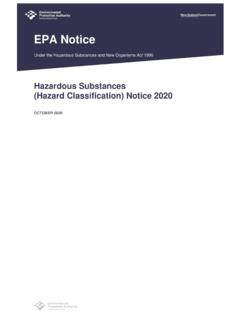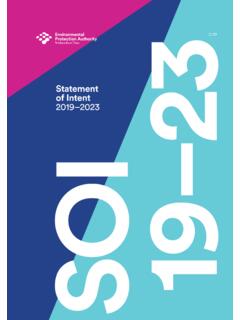Transcription of Glyphosate in Aotearoa New Zealand - EPA
1 Glyphosate in Aotearoa New Zealand 11 May 2022. Summary report on the call for information Glyphosate summary | 1. 2 | May 2022. Disclaimer The purpose of this report is to summarise responses to the call for information. The call for information is only the first step in the EPA. understanding how Glyphosate is currently used in Aotearoa New Zealand . Responses provided to the EPA comprised views, opinions, information, and supporting material (including citations, articles, and reports). In preparing this summary report, the EPA has not substantiated or otherwise verified the information or supporting material provided by responders, and the EPA does not support or otherwise endorse responders' views or opinions, including those reflected in the summary report. The call for information is a non-statutory process that people could voluntarily participate in. Therefore, this summary report only reflects the information provided by and views and opinions of people who voluntarily provided a response.
2 Accordingly, responses and therefore the summary report may not reflect the views of all members of the public, professional users, or organisations across New Zealand that have an interest in Glyphosate and may contain a degree of self-reporting bias. Correction 12 May 2022 We corrected the category of one response and updated the EU review dates. Glyphosate summary | 3. Contents EXECUTIVE SUMMARY 6. BACKGROUND 7. Regulations in Aotearoa New Zealand 7. Overseas regulators 7. Purpose of the call for information 7. SUMMARY OF RESPONSES 9. Responders 9. The reported concerns about Glyphosate 12. Cancer 12. Residues in food 12. Waterways 13. Bee health and residues in honey 13. Surfactants and other co-formulants 14. Off-target effects 14. Soil health 14. Gut health 15. Other health concerns 15. Alleged rule breaking 16. Overuse 16. Resistance 17. The reported benefits of Glyphosate 17. Effective 17.
3 Systemic 17. Broad spectrum 18. Enables reduced or no till agriculture 18. Non-residual 19. Does not leach 19. No withholding period 19. Low human toxicity 20. Low impact on the environment 21. Cost effective 21. Positive economic impact 22. Vital for conservation 22. Helps manage resistance 23. 4 | May 2022. The effects of Glyphosate not being available 24. Proposed positive effects 24. Proposed negative effects 24. Glyphosate use in Aotearoa New Zealand 26. Glyphosate products 27. Quantities imported, manufactured, or sold 28. Domestic use 28. Livestock farming 28. Arable and vegetable farming 29. Orchard use 30. Forestry industry 31. Amenity use 31. Exotic weed control 32. Apiculture industry 34. Spray contractor use 34. Weeds targeted 35. Impacts on M ori 36. Managing the risks of Glyphosate 37. Domestic users 37. Professional users 39. Effectiveness of current controls 40. Proposed changes to current controls 41.
4 Alternatives to Glyphosate 43. Manual and mechanical weeding 43. Soil cultivation 44. Thermal and electrothermal weeding 44. Biocontrol agents 46. Organic herbicides or bioherbicides 46. Other herbicides 47. Alternative landscape or agricultural practices 48. Autonomous robot and drone technologies 49. Responder requests 49. Supplementary information received 50. NEXT STEPS 51. The EPA will decide to seek grounds for reassessment of Glyphosate 51. The EPA will engage with M ori on the topic of Glyphosate 51. The EPA will review POEA surfactants 51. The EPA will reinforce the safe use of Glyphosate 51. Glyphosate summary | 5. Executive summary We have prepared this report following a call for information about the herbicide Glyphosate , issued by the EPA between April and October 2021. This call for information was carried out in recognition of the many concerns that surround Glyphosate , whether they be concerns about its possible impact on human health and the environment or concerns about the effects of Glyphosate being unavailable on agriculture and the larger economy.
5 The use of Glyphosate is a divisive topic, and unsurprisingly, we received a wide range of comments around Glyphosate use in Aotearoa New Zealand . People were concerned about a variety of possible health effects of Glyphosate (including cancer), as well as the potential for environmental harm. They were also worried about the overuse of Glyphosate , calling it a lazy method of weed control, and the possible effects of Glyphosate formulations on bees. On the other hand, lots of people discussed the many benefits of Glyphosate , especially how it has revolutionised farming by allowing no-till agriculture. Many responders said that Glyphosate is vital to their farming business as no single alternative is available that replaces all of Glyphosate 's uses. Responders said that, without Glyphosate , outcomes for the environment and the economy would be worse. Taking into account the responses of industry groups (who represent a large number of people), the majority of responders to the call for information were professional users who stated that Glyphosate , if used according to controls and regulations, is safe and highly beneficial.
6 Others pointed out that any chemical is dangerous if used incorrectly, but that risk can be avoided or mitigated through appropriate protective measures. A few responders stated that the benefits of Glyphosate outweigh the risks. Of the members of the public who responded to the call for information, more than half were non-users of Glyphosate , who felt that Glyphosate was a toxic poison that should be banned or at least restricted. The others were domestic users who mainly supported Glyphosate use, with perhaps some extra restrictions. This call for information is only the first step in gaining a better understanding of how Glyphosate is viewed in Aotearoa New Zealand , and this document is a summary of the responses we received. The next steps for the EPA are to: decide whether to seek grounds for reassessment of Glyphosate engage with M ori on the topic of Glyphosate review POEA surfactants use existing channels to reinforce the safe use of Glyphosate .
7 6 | May 2022. Background Glyphosate is a herbicide used to control weeds. Products containing Glyphosate are among the most common herbicides used in Aotearoa New Zealand , and around the world. It was first approved for use in Aotearoa New Zealand in the 1970s. Glyphosate products are sold under a variety of brand names, with Roundup being the most recognisable brand. Regulations in Aotearoa New Zealand Glyphosate and all Glyphosate -containing products are regulated in Aotearoa New Zealand under the Hazardous Substances and New Organisms Act 1996 (HSNO Act) and the Agricultural Compounds and Veterinary Medicines Act 1997 (ACVM Act). Under the HSNO Act, all hazardous substances, including Glyphosate , must be approved by the EPA before they can be imported or manufactured and therefore used in Aotearoa New Zealand . approved hazardous substances have rules placed on them to reduce risks. Rules include labelling, packaging, and disposal requirements and how to use the substance safely, such as wearing protective clothing, or limiting its use.
8 The ACVM Act regulates the importation, manufacture, sale, and use of all products used in the agricultural and horticultural industries to eliminate pests, treat and prevent diseases, and otherwise manage animals and plants. It also manages risks to trade, agricultural security, public health, and animal welfare along with making sure residue standards for pesticides, veterinary medicines, and other agricultural compounds are met. Anyone using Glyphosate in a workplace must also follow the rules under the Health and Safety at Work Act 2015 and the Health and Safety at Work (Hazardous Substances). Regulations. Councils may impose specific requirements in their local or regional plans. Overseas regulators We, the EPA, monitor international developments and the latest available research on Glyphosate , and our position is aligned with most regulatory bodies around the world, including those from the European Union, the United States, Australia, and Canada.
9 Glyphosate is currently approved for use in the EU until 15 December 2022. That approval is now being reviewed as part of the regular re-registration programme, with a decision due sometime in 2023. Purpose of the call for information The EPA's position on Glyphosate is that it is safe to use provided the specified controls and precautions are followed. That being said, we accept there are some concerns in the community about its possible impacts on human health and the environment. Glyphosate summary | 7. We took a precautionary approach and issued a call for information about Glyphosate and its use, running from April 2021 until October 2021. This call for information is only the first step in understanding how Glyphosate is currently used in Aotearoa New Zealand . The responses allow us to get a better picture of how Glyphosate is used in Aotearoa New Zealand before the EU findings are released in 2023.
10 8 | May 2022. Summary of responses The call for information was open from 28 April 2021 to 22 October 2021. We received 469. responses during this time, though, we found four duplicate responses, dropping the total number of responses to 465. We received responses from individuals, businesses, and organisations across Aotearoa New Zealand (and two responses from overseas Australia and the United States). Each response reflected in this report can be viewed on our website. Responders While most of the responses were from individuals or individual organisations, 14 responses were from industry groups who represent a larger number of interested parties (see Table 1. below for more details). Unless otherwise stated, we have taken the number of people or organisations represented from the industry group responses. Table 1. Industry groups who responded to the call for information Responder name Representing Agcarm (Agricultural chemical and Animal Manufacturers of crop protection and Remedy Manufacturers Association) animal health products, including 14.







